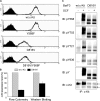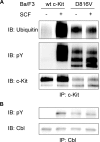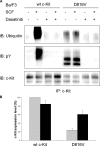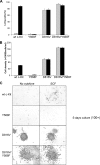The D816V mutation of c-Kit circumvents a requirement for Src family kinases in c-Kit signal transduction
- PMID: 19265199
- PMCID: PMC2670109
- DOI: 10.1074/jbc.M808058200
The D816V mutation of c-Kit circumvents a requirement for Src family kinases in c-Kit signal transduction
Abstract
The receptor tyrosine kinase c-Kit plays a critical role in hematopoiesis, and gain-of-function mutations of the receptor are frequently seen in several malignancies, including acute myeloid leukemia, gastrointestinal stromal tumors, and testicular carcinoma. The most common mutation of c-Kit in these disorders is a substitution of the aspartic acid residue in position 816 to a valine (D816V), leading to constitutive activation of the receptor. In this study, we aimed to investigate the role of Src family kinases in c-Kit/D816V signaling. Src family kinases are necessary for the phosphorylation of wild-type c-Kit as well as of activation of downstream signaling pathways including receptor ubiquitination and the Ras/Mek/Erk pathway. Our data demonstrate that, unlike wild-type c-Kit, the phosphorylation of c-Kit/D816V is not dependent on Src family kinases. In addition, we found that neither receptor ubiquitination nor Erk activation by c-Kit/D816V required activation of Src family kinases. In vitro kinase assay using synthetic peptides revealed that c-Kit/D816V had an altered substrate specificity resembling Src and Abl tyrosine kinases. We further present evidence that, in contrast to wild-type c-Kit, Src family kinases are dispensable for c-Kit/D816V cell survival, proliferation, and colony formation. Taken together, we demonstrate that the signal transduction pathways mediated by c-Kit/D816V are markedly different from those activated by wild-type c-Kit and that altered substrate specificity of c-Kit circumvents a need for Src family kinases in signaling of growth and survival, thereby contributing to the transforming potential of c-Kit/D816V.
Figures







Similar articles
-
PI3 kinase is indispensable for oncogenic transformation by the V560D mutant of c-Kit in a kinase-independent manner.Cell Mol Life Sci. 2015 Nov;72(22):4399-407. doi: 10.1007/s00018-015-1944-9. Epub 2015 Jun 4. Cell Mol Life Sci. 2015. PMID: 26040420 Free PMC article.
-
KITD816V Induces SRC-Mediated Tyrosine Phosphorylation of MITF and Altered Transcription Program in Melanoma.Mol Cancer Res. 2017 Sep;15(9):1265-1274. doi: 10.1158/1541-7786.MCR-17-0149. Epub 2017 Jun 5. Mol Cancer Res. 2017. PMID: 28584020
-
The c-Kit/D816V mutation eliminates the differences in signal transduction and biological responses between two isoforms of c-Kit.Cell Signal. 2009 Mar;21(3):413-8. doi: 10.1016/j.cellsig.2008.11.008. Epub 2008 Nov 17. Cell Signal. 2009. PMID: 19049823
-
Signal transduction via the stem cell factor receptor/c-Kit.Cell Mol Life Sci. 2004 Oct;61(19-20):2535-48. doi: 10.1007/s00018-004-4189-6. Cell Mol Life Sci. 2004. PMID: 15526160 Free PMC article. Review.
-
Structure and regulation of Kit protein-tyrosine kinase--the stem cell factor receptor.Biochem Biophys Res Commun. 2005 Dec 23;338(3):1307-15. doi: 10.1016/j.bbrc.2005.09.150. Epub 2005 Oct 4. Biochem Biophys Res Commun. 2005. PMID: 16226710 Review.
Cited by
-
Evolution of KIPPIS as a versatile platform for evaluating intracellularly functional peptide aptamers.Sci Rep. 2021 Jun 3;11(1):11758. doi: 10.1038/s41598-021-91287-z. Sci Rep. 2021. PMID: 34083659 Free PMC article.
-
SRC-Family Kinases in Acute Myeloid Leukaemia and Mastocytosis.Cancers (Basel). 2020 Jul 21;12(7):1996. doi: 10.3390/cancers12071996. Cancers (Basel). 2020. PMID: 32708273 Free PMC article. Review.
-
Persistent Human KIT Receptor Signaling Disposes Murine Placenta to Premature Differentiation Resulting in Severely Disrupted Placental Structure and Functionality.Int J Mol Sci. 2020 Jul 31;21(15):5503. doi: 10.3390/ijms21155503. Int J Mol Sci. 2020. PMID: 32752102 Free PMC article.
-
Protein tyrosine phosphatase receptor type E (PTPRE) regulates the activation of wild-type KIT and KIT mutants differently.Biochem Biophys Rep. 2021 Mar 2;26:100974. doi: 10.1016/j.bbrep.2021.100974. eCollection 2021 Jul. Biochem Biophys Rep. 2021. PMID: 33732906 Free PMC article.
-
A novel anti-c-Kit antibody-drug conjugate to treat wild-type and activating-mutant c-Kit-positive tumors.Mol Oncol. 2022 Mar;16(6):1290-1308. doi: 10.1002/1878-0261.13084. Epub 2021 Aug 29. Mol Oncol. 2022. PMID: 34407310 Free PMC article.
References
-
- Lennartsson, J., and Rönnstrand, L. (2006) Curr. Cancer Drug Targets 6, 65–75 - PubMed
-
- Ning, Z. Q., Li, J., and Arceci, R. J. (2001) Leuk. Lymphoma 41, 513–522 - PubMed
-
- Beghini, A., Peterlongo, P., Ripamonti, C. B., Larizza, L., Cairoli, R., Morra, E., and Mecucci, C. (2000) Blood 95, 726–727 - PubMed
Publication types
MeSH terms
Substances
LinkOut - more resources
Full Text Sources
Other Literature Sources
Molecular Biology Databases
Miscellaneous

